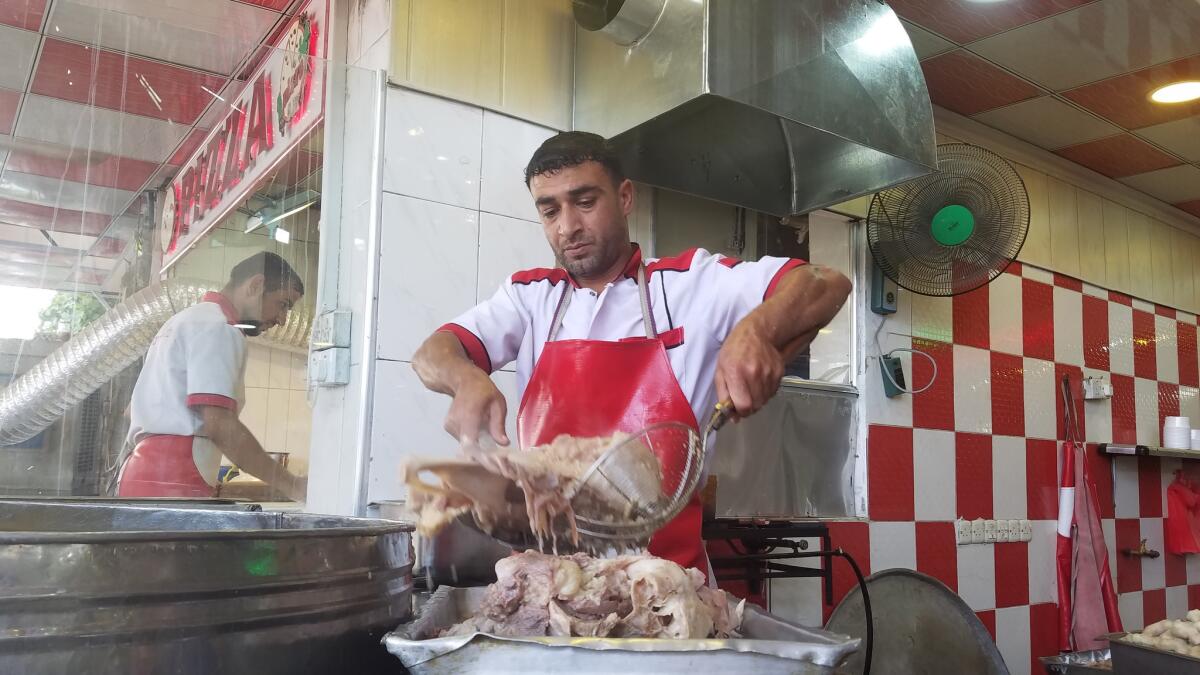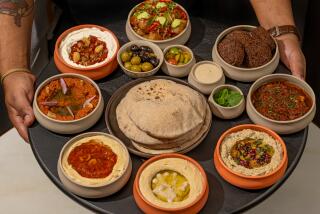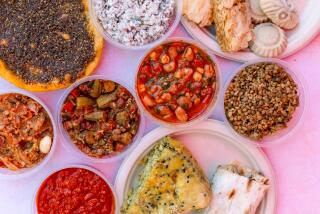Pache, a stew of sheep and cow innards, may not look appetizing, but the people of Mosul adore it

- Share via
Reporting from Mosul, Iraq — The annals of food preparation have no lack of the gruesome. Still, it’s hard to envision a more macabre process than the one that yields pache (pronounced PAH-tshe), the piece de resistance of Mosul’s unique cuisine.
The Iraqi city, where the government recently declared victory over Islamic State militants, is famous all over Iraq for its pancake-like version of kibbeh (a patty of bulgur and spiced meat with raisins) and dolma (an especially fatty take on the stuffed-grape-leaves dish). But it’s the city’s version of pache, a veritable witch’s brew of sheep and cow offal, that has Muslawis crowding the city’s restaurants, even as the thumps and crashes of battle can be heard nearby.
It all begins many hours before eating, when Mohammad Tareq Azzawi, 48, unloads animal heads, feet, intestines and other parts in the yard of his house in east Mosul.
Azzawi, like his father and grandfather before him, is a samaat (literally, a person who deals with scalding water). It falls to him to remove all the hair and dirt from the carcasses, the first step in the arduous cleaning that is the overriding consideration in making pache.
His tools (a bicycle pump, skewers fashioned from metal rebar, a rusty oil barrel) are as rudimentary as his surroundings. The raging battles in west Mosul destroyed the main slaughterhouse where he used to work, forcing Azzawi and his colleagues to use his frontyard as a makeshift abattoir.
“If they show this in the U.S., we might have the World Health Organization after us. The Americans helping us here will run away,” he jokes as he inserts a hose into a severed sheep’s head before turning to push the bicycle pump nearby. The cheeks and ears inflate like a balloon, separating the skin from the flesh and pushing out the tongue.

Warning: This video contains imagery of animals after slaughter. Pache, a stew of sheep and cow innards, may not look appetizing, but Muslawis (the people of Mosul, Iraq) adore it. (Nabih Bulos / Los Angeles Times)
“We used to prepare 20 to 25 carcasses a day,” he continues. “Now it’s much less.”
After a soak in almost boiling water, the carcasses are ready for a shave worthy of Sweeney Todd, the air filled with the clacking of knives and the oddly soothing susurration of razors against skin. Piles of blood-stained wool cover the ground.
Azzawi then delivers the de-haired parts and intestines to pachachis around Mosul such as Tayseer Uqayl Qassem. Deep in the bowels of one of the city’s top restaurants (the owner demurred to identify its name for reasons of security), Qassem spends no less than three hours obsessively checking every hoof and snout that come before his critical eye.
Qassem brandishes a slab of cow tongue, running its rough surface over a skinned cow head (“It’s the best way to remove any remaining hair,” he explains). He takes a knife to a foot, removing the inside of the cleft hoof before whacking it with an ax to expose its marrow, which will release more flavor into the broth.
“It’s all about cleanliness with pache. It’s our favorite food in Mosul, and we all know the places that make it well,” Qassem says.
He turns to the intestines piled on the table behind him. Qassem has already used 27 pounds of salt mixed in water to sluice the unruly mass. Now he stuffs them with piles of rice spiced with garlic and pepper.
“We usually make more than 100 pounds of intestines per day and 10 heads,” he says. On major holidays like Eid al-Fitr (the celebration that marks the end of Ramadan), the restaurant will prepare five times as much.
Giving the parts a final wash, Qassem speaks of pache with something approaching awe.
“My son, when he was 6 months old, I started to give him the broth of the pache so he wouldn’t be a weakling. He loved it,” he says, boasting that by the time his son was 2, he could lug a 44-pound gas canister.
“His mother was amazed.”
A large bubbling cauldron of water and salt awaits the now cleaned offal, which will stew for five hours. But even here attention is required: A vigilant pachachi will add the different animal parts at different times (more sensitive parts like the brain and tongue are added later) to make sure they cook perfectly, while removing any scum that bubbles to the surface.
Once it’s done, dozens of people begin to show up with pots ready to be filled with a family takeaway portion. Pachachi Maher Nuaimi, meanwhile, begins to assemble bowls for the cluster of customers getting delirious on the aroma. (A visiting reporter is not immune to this.)
Nuaimi begins with a lining of pita bread at the bottom of the bowl, then places a few pieces of intestines with a bit of tongue, brain and feet. He tops it off with a few precious morsels of cheek from a nearby sheep head, its teeth bared in a grin.
A few ladles of the rich broth, a quick splash of lemon juice infused with garlic, and it’s ready.
Diners strategize in the way they eat pache. The intestines, brain and tongue are dispatched quickly. Then every bit of meat is teased out of the feet, the marrow succumbing after a vigorous slurp. For the coup de grace, the bread is used to sop up every last drop of the fat-infused broth.
Prepared well, pache rewards the intrepid diner with a delicate meaty flavor that is never overshadowed by the rich patina of fat. The textures of the different parts combine, while the lemon and garlic (not to mention the obsessive cleaning) chase away any gaminess one might expect in such a dish.
It’s finished all too soon.
Twitter: @nabihbulos
ALSO
‘I watched her die’: The last push for Mosul, from those who lived through the ferocious battle
Pastry, fat, and perfection: A recipe for Baghdad’s favorite breakfast food
Wastewater on a stick: The popsicles from Taiwan that you really, really don’t want to eat
More to Read
Sign up for Essential California
The most important California stories and recommendations in your inbox every morning.
You may occasionally receive promotional content from the Los Angeles Times.











